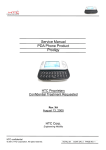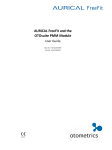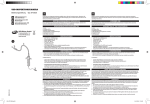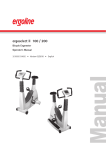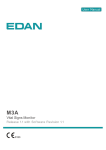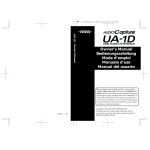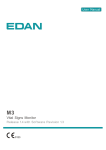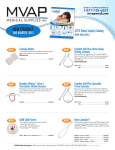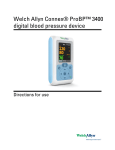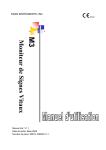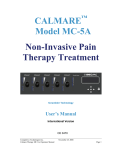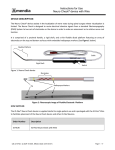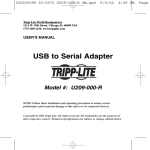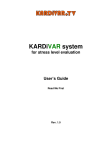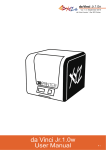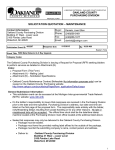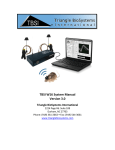Download - Frank`s Hospital Workshop
Transcript
Nerve stimulator TWISTER® INSTRUCTIONS FOR USE Softwareversion 1.19 Manufacturer: Dr. Langer Medical GmbH Fabrik Sonntag, Haus 4a 79183 Waldkirch Germany Table of contents 1 Intended use..................................................................................................................... 5 2 Common notes ................................................................................................................. 6 3 Installation ........................................................................................................................ 8 3.1 Software installation............................................................................................... 8 3.2 TWISTER USB-driver installation......................................................................... 8 3.3 Sound interface setup ............................................................................................ 9 ® 4 Functional principals and operation .................................................................................10 4.1 Front side description............................................................................................11 4.2 Control outputs and inputs at the rear side of the device ......................................12 4.2.1 Description of the combination with third party devices .................................12 4.3 TWISTER® start up...............................................................................................13 4.4 TWISTER® shut down...........................................................................................17 5 TWISTER® operation.......................................................................................................18 5.1 Main window controls............................................................................................18 5.2 Main window indicators .........................................................................................27 5.3 Pulse shape editor ................................................................................................28 5.3.1 Drawing a new pulse shape ..........................................................................29 5.3.2 Changing an existing pulse shape.................................................................31 6 Basic safety instructions ..................................................................................................33 6.1 Follow all instructions in the instructions for use ...................................................33 6.2 Operator obligation ...............................................................................................33 6.3 User obligation......................................................................................................33 6.4 Dangers using the TWISTER® stimulator ..............................................................34 6.5 Preventing electromagnetic interferences .............................................................40 6.6 Warranty and liability.............................................................................................40 7 Safety instructions ...........................................................................................................41 7.1 Symbols and declarations .....................................................................................41 7.2 Informal safety measures......................................................................................41 7.3 Personnel training .................................................................................................41 7.4 Safety measures during normal operation ............................................................42 7.5 Constructional changes at TWISTER® ..................................................................42 ® TWISTER Softwareversion 1.19 Page 3 of 46 Version 1.19-4 / 2010-05-31 8 Copy right....................................................................................................................42 9 User’s manual copying ................................................................................................42 10 Technical data.............................................................................................................43 11 Serial number design ..................................................................................................44 12 Disposal of waste ........................................................................................................44 13 Cleaning......................................................................................................................44 14 Service and repair .......................................................................................................44 15 Accessories.................................................................................................................45 16 PC performance requirements ....................................................................................45 17 Manufacturer address .................................................................................................46 ® TWISTER Softwareversion 1.19 Page 4 of 46 Version 1.19-4 / 2010-05-31 1 Intended use ® TWISTER is a freely programmable electrical nerve stimulator to evoke biopotentials on the human body. ® TWISTER is connected to a PC via USB link. The USB link is not considered application part B and BF. It is double isolated from the patient outputs and power supply. The controlling PC does not need a medical isolation. TWISTER® has 4 stimulation outputs. Each channel can be selected via software. The pulse intensity can be controlled by the software or by the quick access buttons at the front panel. The TWISTER® operating user must be trained and familiar with the impacts of electrical stimulation to the human body! In addition to standard pulses, the operator can configure and store pulse shapes graphically. Thus the stimulator TWISTER® can also be used for special diagnostic purposes at human beings. TWISTER® has been developed for nerve stimulation only. A different or exceeding use does not apply to the term intended use. Dr. Langer Medical GmbH is not liable for harms caused by a non-intended use. Please consider implicitly the notes mentioned in article 6.4: Dangers using the TWISTER® stimulator The intended use is based on the compliance with the required service and maintenance intervals. ® TWISTER Softwareversion 1.19 Page 5 of 46 Version 1.19-4 / 2010-05-31 2 Common notes The exact attention to the instructions for use is the main requirement for the intended use and the correct handling of the device and the resulting safety for the patient and the operator. It is not allowed to use accessories not approved with the device by the manufacturer and not listed in the instructions for use. In case of any use of accessories not listed in the instructions for use, the technical and biological harmlessness has to be proved. All printed documents comply with the delivered devices and the current safety standards when printed. All rights are reserved for the mentioned devices, circuitries, methods, software programs and names. The use of needle electrodes together with electro surgery devices can cause an increased risk of burns at the contact between the electrode and the skin. For this reason all advices and safety instructions of electro surgery devices have to be studied carefully and followed by the users. In addition, all devices measuring impedance or current have to undergo an electrical safety check on a regular time frame. Caution: Needle electrodes should be applied as far as possible away from the electro surgery devices to avoid burns caused by induced currents in result from radio frequency fields. Thus the electro surgery device should not be placed close to the patient’s head or neck in case of a surgery. All cables of these devices should be placed as far away as possible from other electrode cables particularly using monopolar instruments. ® TWISTER Softwareversion 1.19 Page 6 of 46 Version 1.19-4 / 2010-05-31 Before starting surgery, the risk of injuries of the nerves to be examined as well as burns caused by interactions between electro surgical devices and the TWISTER® nerve stimulator, should be balanced. Only those needle electrodes are allowed to be used which are approved for use with ® ® TWISTER by the manufacturer. In case non sterile electrodes are used with TWISTER , the needle electrodes must be sterilized. Before using the needle electrodes the user’s instructions and in case of reusable electrodes the manufacturer’s sterilization directives have to be studied carefully and followed up. The same applies to the use of stimulation probes accordingly. Only those stimulation probes provided by the manufacturer are allowed to be used. The stimulation probes must be sterilized before each use following the user’s instructions and manufacturer’s sterilization directives. ® TWISTER Softwareversion 1.19 Page 7 of 46 Version 1.19-4 / 2010-05-31 3 Installation 3.1 Software installation Insert the TWISTER® software CD into the CD-Rom drive and follow the prompts of the installation wizard. Please consider, that during installation of the software, the stimulator TWISTER® may not be connected to the computer. 3.2 TWISTER® USB-driver installation Please consider that for the USB-driver installation the TWISTER® has to be connected to the PC which controls TWISTER®. To install the USB-driver for the nerve stimulator TWISTER®, some configurations in the “Device Manager” have to be modified. The “Device Manager” can be opened by the follwing path: START Control Panel System Tab “Hardware” “Device Manager” Enlarge “Universal Serial Bus Controllers” and choose “Micronas USB Verbundgerät” in the “Device Manager”. Use the right-click to choose “Update Driver”. The Update Manager is opened. ® Choose: “Yes, this time only” Click “Next” Choose: “Install from a specific list or specific location” Click “Next” Choose: “Don’t search, I will choose the driver to install” Click “Next” Choose: “TWISTER-HS” Click “Next” follow the instructions to finish USB-driver installation TWISTER Softwareversion 1.19 Page 8 of 46 Version 1.19-4 / 2010-05-31 3.3 Sound interface setup For correct audio playback the sounds and audio devices have to be reconfigured. Therefore switch to: START Control Panel Sounds & Audio Devices Tab “Audio” For “sound playback” the internal sound card must be set as default device. NOT TWISTER-HS! For “sound recording” the internal sound card must be set as default device. NOT TWISTER-HS! Please checkmark the box for “Use only default devices”! ® TWISTER Softwareversion 1.19 Page 9 of 46 Version 1.19-4 / 2010-05-31 4 Functional principals and operation The maximum voltage is +/- 200 Volts. The operational indicator (READY) at the front panel of the TWISTER® shows, that the TWISTER® is ready to deliver stimulation pulses. The electrode output is twice isolated against power supply and the control unit, consisting of the trigger output, footswitch input and USB link and thus potential free. Only those electrodes approved by the Dr. Langer Medical GmbH are allowed to be connected to the electrode output. The stimulation current density must not exceed 2 mA / cm². Energy limitation: TWISTER® monitors the energy delivered to the electrodes. The energy is measured at a 1000 Ohm resistance and limited to a maximum of 50 mJ. The exceeding will be signalized by the software. ® TWISTER Softwareversion 1.19 Page 10 of 46 Version 1.19-4 / 2010-05-31 4.1 Front side description Increasing stimulation current Decreasing stimulation current Stimulation start / stop, single pulse in footswitch mode CH1/2: Connector for stimulation channels 1 and 2 CH3/4: Connector for stimulation channels 3 and 4 Power: Power supply indicator (switched on -> green) Ready: Stimulator is ready to deliver stimulation pulses (yellow) PC Link: PC connected, control software started (green) ® TWISTER Softwareversion 1.19 Page 11 of 46 Version 1.19-4 / 2010-05-31 4.2 Control outputs and inputs at the rear side of the device Power module: Power switch to turn TWISTER® on and off USB-Host Connector: USB cable connector to PC Footswitch: External footswitch connector Trigger Out: TTL trigger output for connection to third party monitoring systems 4.2.1 Description of the combination with third party devices A third party monitoring device can be triggered via Trigger Out. The trigger out pulses are time synchronously with the stimulation pulses. The trigger out pulse is fired with the first pulse in burst mode! USB-Host Connector: The USB cable connecting TWISTER® to the controlling PC is connected to this connector. The controlling PC must meet the minimum requirements described in chapter 16! Footswitch: A footswitch can be connected to this connector. The Footswitch must comply with protection class IPX1. An approved footswitch can be purchased optionally from the manufacturer. ® TWISTER Softwareversion 1.19 Page 12 of 46 Version 1.19-4 / 2010-05-31 4.3 TWISTER® start up First start up The operator must not start up the device before the manufacturer or dealer - has checked the correct device function at the customer’s site, - has introduced the responsible users in the correct operation of the device. TWISTER® has to be started up as follows: Use the power cable shipped with the device to connect it to the power supply. The power supply connector can be found at the rear side of the device. The TWISTER® device can be switched on now. The power switch is also located at the rear side of the device. The green power LED at the front side indicates the correct operation. The included USB link cable has to be connected to the „USB Host Connector“ at the rear side of the TWISTER®. Regardless whether the controlling PC is switched on or off, the USB link cable has to be connected to the PC. The PC must have at least one unused USB link, PCs w/o USB connector cannot be used for TWISTER® operation. The stimulation cables are connected to the device’s front side. According to the desired stimulation channel, one of the two patient output connectors have to be chosen. The stimulation channel is finally selected by the software. To trigger an external monitoring device a connection between the trigger output at the rear side of the TWISTER® to the trigger input of the external monitoring device has to be established. Optionally an external footswitch can be connected at the rear side of the device. The footswitch is used to fire single pulses. Now the TWISTER® PC software can be started. After a correct installation the green LED light “PC Link” at the front side of the TWISTER® indicates a correct operation. ® TWISTER Softwareversion 1.19 Page 13 of 46 Version 1.19-4 / 2010-05-31 The program’s main window opens (Figure 1) and signalizes the correct operation of the system. An error message will appear while programming the PC with non MS Windows 2000 Professional or MS Windows XP Professional system software (upon confirmation of the error message the program will be aborted). Figure 1: Main window If the TWISTER® is not connected to the power supply or not switched on, the following error message appears (Figure 2). ® Figure 2: Error message, TWISTER not connected to the power supply or switched off ® TWISTER Softwareversion 1.19 Page 14 of 46 Version 1.19-4 / 2010-05-31 ® Connect the power cable to the power supply and switch the TWISTER device on. After clicking the <No> button the error message will disappear. With <Yes> the program can be closed. If the USB device driver is not properly installed at the PC or if the USB link cable is not connected or if the PC does not have a built-in sound board, the following error message appears (Figure 3). Figure 3: Incorrect USB device driver installation or USB link cable not properly connected Connect (if applicable) the USB link cable to the connector at the rear side of the TWISTER® and to the PC’s USB connector. Then push the <No> button and the error message will disappear. If the error message continues to appear, contact the customer service of Dr. Langer Medical GmbH. If an error message according to Figure 4 appears, you have to adjust the PC’s audio setup. Figure 4: Configuration error in the audio and multimedia setup ® TWISTER Softwareversion 1.19 Page 15 of 46 Version 1.19-4 / 2010-05-31 Therefore check the configurations made according to chapter 3.3: Sound interface setup! If necessary redo the sound interface setup! If the error message continues to appear, contact the customer service of Dr. Langer Medical GmbH. If TWISTER® is not connected to the PC via the USB link cable the TWISTER® software can be started in DEMO mode by pushing the <Demo> button. This mode shows you a flashing message „Demo-Mode“ at the bottom of the main window (Figure 5). To leave the demo mode, the software must be closed by pushing the <Quit> button and restarted afterwards. Figure 5: Demo mode ® TWISTER Softwareversion 1.19 Page 16 of 46 Version 1.19-4 / 2010-05-31 4.4 TWISTER® shut down TWISTER® has to be switched off as follows: The device is switched off using the power switch at the rear side of the device. The green „Power“ LED light is turned off. If the PC is still switched on, the green „PC Link“ LED remains on. This function can be compared to a sleep mode. By switching off the PC or disconnecting the USB link cable the TWISTER® is switched off completely. ® TWISTER Softwareversion 1.19 Page 17 of 46 Version 1.19-4 / 2010-05-31 5 TWISTER® operation 5.1 Main window controls The main window is divided in several control groups. Figure 6 shows the controls to setup the pulse shapes for single and burst stimulation, the stimulation frequency as well as the controls for sequential stimulation. Figure 6: Controls in the upper left part of the main window Frequency [Hz]: Stimulation frequency setup in the range of 1 … 1000 Hz Pulse width [µs]: Pulse width setup in the range of 50 … 1000 µs Polarity: Polarity setup of the rectangular stimulation pulse: positive, negative or alternating (positive-negative). The pulse width in alternating mode is the value for each of the both polarities. The complete pulse is thus twice the selected pulse width long. Pulse number: Pulse number setup in burst stimulation mode in the range of 2 …10. This control is disabled and dimmed when single pulse or pulse shape is selected. ISI [ms]: Interstimulus interval setup in burst stimulation mode in the range of 1 … 200 ms. The interstimulus interval is the break between two subsequent pulses in burst stimulation mode. ® TWISTER Softwareversion 1.19 Page 18 of 46 Version 1.19-4 / 2010-05-31 Channel: Stimulation channel setup in the range of 1 … 4. Please check the correct connection of the stimulation output cable at connector 1 (CH1/2) for channel 1 or 2, or connector 2 ® (CH3/4) for the channels 3 or 4 at the front side of the TWISTER . Sequence: Switching sequential stimulation on or off. In this mode the selected number of stimulation pulses will be fired. Afterwards the stimulation pauses for the preselected time and will be restarted automatically again. This mode of stimulation is particularly suitable for SEP. With a sequential stimulation an additional display “Sequence Status:” will appear with pulse number and break time in seconds (Figure 7). Figure 7: Controls to setup sequential stimulation A stimulation with frequencies less than < 1Hz can be configured in sequential mode. Choose “1” in the field <Stimulations>. The value in the field <Break [s]:> is the time period between two subsequent pulse sequences, in the case of one stimulation between two subsequent single pulses. Stimulations: Number of stimulations in a stimulation sequence in the range of 1 … 2000. If the checkbox <Sequence:> is not marked, the sequence setup controls appear dimmed and disabled. ® TWISTER Softwareversion 1.19 Page 19 of 46 Version 1.19-4 / 2010-05-31 Break [s]: Time period between two subsequent stimulation sequences in the range of 1 … 300 seconds. If the checkbox is not marked the <Break [s]:> value is disabled and dimmed. Thus the running sequence stops after the system has reached the number of stimulations the first time. In the right part of the main window the controls for the stimulation current can be found. The current can be changed in the range of 1 … 100 mA (Figure 8). The controls labelled with arrows are used to increase or decrease stimulation current. The double arrow buttons increase or decrease the stimulation current in steps of 1 mA, single arrow buttons in steps of 0.1 mA. At the TWISTER® front side you can also find two buttons labelled with arrows. They have the same functionality as the double arrow buttons in the software interface. Holding down the buttons for a long time increases or decreases the current continuously. A time delay prevents rapid current changings. Figure 8: Stimulation current controls Because of safety reasons the stimulation current is set to 1.5 mA after starting the software or a new program. The maximum current value can be configured and stored together with the selected program. It is displayed in the yellow line above the signal graph (Figure 7). ® TWISTER Softwareversion 1.19 Page 20 of 46 Version 1.19-4 / 2010-05-31 With the controls located at the left side (Figure 9), complete configurations can be stored and opened when required by a click on the desired program key. Figure 9: Controls to store and call complete configurations To store the current configuration push the <Store> button first and then the desired program key <P1 … P5>. To open a stored configuration, directly click the desired program key <P1 … P5>. A program name can be edited in the yellow range „Program:“ (Figure 5) above the signal graph before a program is stored. It helps to identify the program. ® TWISTER Softwareversion 1.19 Page 21 of 46 Version 1.19-4 / 2010-05-31 The controls in the lower part of the main window (Figure 10) contain the main functions of ® the stimulator TWISTER . ® Figure 10: TWISTER main controls Help: Help window with short instructions Single / Burst / Shape: Pulse type selection for single pulses, burst pulses or pulse shapes. The active button is marked in yellow colour. If burst pulse or pulse shape is selected, the configured pulse shape is displayed in the pulse preview window in the upper right corner of the main window (Figure 11). Figure 11: Pulse preview If single pulse is selected the pulse preview appears dimmed. Pulse Shape Editor: A window will open after pushing this button showing the pulse shape editor for programming free pulse shapes. If pulse shape is selected as the type the buttons <Edit Pulse shape> and <Select Pulse shape> appear enabled and active. ® TWISTER Softwareversion 1.19 Page 22 of 46 Version 1.19-4 / 2010-05-31 Select Pulse shape: To select a pulse shape from a directory of stored pulse shapes (Figure 12). If pulse shape is selected as pulse type the <Select Pulse shape> button appears enabled and active Status Display (Performance): With the key combination <Ctrl><Shift><F1> status indicators are displayed ® to check the performance of the PC system controlling the TWISTER hardware. Contact the service to get more information about the status controls. Figure 12: Pulse shape selection The selected pulse shape is displayed in the pulse preview (Figure 11). ® TWISTER Softwareversion 1.19 Page 23 of 46 Version 1.19-4 / 2010-05-31 Footswitch: Pushing this button will enable the footswitch mode. The blue button colour indicates the active footswitch mode. By clicking the connected footswitch, single pulses or pulse shapes can be fired. Those controls which are not needed in this mode or which are not allowed to be changed, are disabled and dimmed (Figure 13). As soon as the footswitch mode is disabled by pushing the <Footswitch> button again, these controls will be enabled again. Figure 13: Main window in footswitch mode Start / Stop: To start and stop the stimulation. Starting the stimulation will cause the button to change to green colour indicating a running stimulation. The label will change to <Stop>. Unnecessary controls or those which are not allowed to be changed during a running stimulation are disabled and dimmed (Figure 14). Start / stop can also be controlled by the START/STOP labelled button at the front side of the TWISTER®. ® TWISTER Softwareversion 1.19 Page 24 of 46 Version 1.19-4 / 2010-05-31 Figure 14: Running stimulation During stimulation the system calculates the pulse energy. When the pulse energy exceeds the maximum limit of 50 mJ, the stimulation pulses are no longer transmitted to the patient electrodes. The pulse graph display continues to run but the indicator for pulse energy at the right side of the main window starts flashing (Figure 15). Additionally a beep tone indicates this warning. Figure 15: Flashing energy display in case of overshooting maximum pulse energy ® TWISTER Softwareversion 1.19 Page 25 of 46 Version 1.19-4 / 2010-05-31 Furthermore, the selected stimulation frequency is verified compared to the configured pulse width. In burst or pulse shape mode, the pulse width includes all pulses or the complete shape, respectively. If the frequency is chosen too high, there is not enough time to generate complete pulses and to separate them from each other. In this case the frequency control starts flashing (Figure 16) and an acoustic warning can be heard. Figure 16: Stimulation frequency is too high to stimulate complete pulse shapes, the frequency display flashes If the PC performance is too low to control the stimulator TWISTER®, an error message appears (Figure 17). If this message continuous to appear after all other applications have been closed, the PC is not suitable for this application (cp. chapter 16: PC performance requirements). ® TWISTER Softwareversion 1.19 Page 26 of 46 Version 1.19-4 / 2010-05-31 This message can also appear immediately after the PC was switched on, if other programs running in the background or system services consume too much CPU performance. Wait a moment before starting the first stimulation in this case. Figure 17: System performance too low ® Quit the TWISTER application program Quit: 5.2 Main window indicators Energy [mJ]: Pulse energy display during a running stimulation. If the value exceeds 50 mJ the stimulation will be discontinued and the display flashes . kOhm: Electrode impedance display. The display is blank if the signal amplitudes are too small or if the signal is disturbed. A value is calculated only during stimulation. Online-signal graph: The signal graph shows the current and voltage signal during stimulation. The scale colours show which scale belongs to which signal. 10 Pulses are displayed every time regardless to the selected stimulation frequency. The timescale will be adjusted according the selected stimulation frequency. In the footswitch mode the time scale is set to 10 seconds. ® TWISTER Softwareversion 1.19 Page 27 of 46 Version 1.19-4 / 2010-05-31 5.3 Pulse shape editor The pulse shape editor allows to configure pulse shapes graphically, which exceed the standard configuration capabilities. The pulse shape editor can be opened by pushing the <Edit Pulse shape> button in the main window (Figure 18). To enable this button, pulse shape must be selected as pulse type. If a pulse shape does already exist it will be displayed in the pulse graph. It can be changed or a new shape can be drawn. Figure 18: Pulse shape editor ® TWISTER Softwareversion 1.19 Page 28 of 46 Version 1.19-4 / 2010-05-31 5.3.1 Drawing a new pulse shape • Choose the desired total pulse width using the control <Max.Time [ms]> (range of 0,1 … 50 ms) before starting to draw the shape. • Push the <Draw> button. The button’s background colour changes to green and the <New> button changes to enabled state, allowing to delete existing pulse shapes from the pulse graph and to start with a new drawing. • Start to draw using the left mouse key and moving the mouse over the black area of the pulse graph. The values for amplitude and time at the mouse position can be checked with the indicators for „Time [ms]“ and „Amplitude [%]“. Fix each end point of your desired pulse shape with a mouse click. Move the mouse cursor to the right only, drawing to the left is not possible. You can always extend the total pulse width by changing the value in the „Max. Time [ms]“ control. After clicking the last point (Figure 19) the pulse shape can be stored together with a name, helping to identify it, using the <Save> button. This key is disabled, if no pulse shape exists in the pulse graph area. Figure 19: Drawn pulse shape ® TWISTER Softwareversion 1.19 Page 29 of 46 Version 1.19-4 / 2010-05-31 • The amplitude of the pulse shape is defined as a value between -100 … 100%. During stimulation it is the percentage of the selected stimulation current in the main window (cp. Figure 8). Example: Amplitude value in pulse shape: 80% Selected stimulation current in main window: 20mA Stimulated current [mA] Amplitude value in pulse shape [%] * selected stimulation current in main window [mA] = -------------------------------------------------------------------------------------------------------------------100 The stimulated current is 16mA in this case. ® TWISTER Softwareversion 1.19 Page 30 of 46 Version 1.19-4 / 2010-05-31 5.3.2 Changing an existing pulse shape • If the <Draw> button is pushed again and a pulse shape exists in the pulse graph the <Adjust> button becomes enabled, otherwise it is disabled and dimmed. Push the <Adjust> button to change an existing pulse shape. The button’s background changes to green colour (Figure 20). As soon as you click close to the point you want to change in the pulse graph area, the shape’s colour changes to green, indicating that it is in adjust mode. The selected point can be changed in its time and amplitude by moving the mouse now. By a left mouse click the point is fixed in its new position, the shape’s colour changes to blue again. The pulse shape can also be extended to the right by changing the value in the control <Max. Time [ms]>. Figure 20: Changing an existing pulse shape • By pushing the button <Open>, stored waveform files for further operation can be opened. ® TWISTER Softwareversion 1.19 Page 31 of 46 Version 1.19-4 / 2010-05-31 OK: Closing the pulse shape editor accepting the existing pulse shape. The shape is displayed in the pulse preview in the main window. Cancel: Closing the pulse shape editor and discarding the selected pulse shapes. The status in the main window will be the one before the pulse shape editor was opened. Help: Help window with short instructions. If pulse shape is selected as pulse type and no pulse shape is chosen (empty pulse preview), an error message will appear (Figure 21). Choose or generate a pulse shape and start the stimulation again. Figure 21: Pulse shape chosen as pulse type but no shape selected ® TWISTER Softwareversion 1.19 Page 32 of 46 Version 1.19-4 / 2010-05-31 6 Basic safety instructions 6.1 Follow all instructions in the instructions for use Basic requirement for the correct operation and handling of the nerve stimulator TWISTER® as well as the failure-free function is the detailed knowledge of the basic safety requirements and standards. This user’s manual contains the most important advices to operate the nerve stimulator ® TWISTER according to the safety requirements and standards. This user’s manual and particularly the safety instructions have to be followed by all users working with the nerve stimulator TWISTER®. Additionally all locally valid safety instructions and requirements to avoid harms have to be followed. 6.2 Operator obligation The operator is obliged, to allow only those staff working with the stimulator TWISTER®, who ❒ are familiar with the TWISTER®’s functionality and handling and who are instructed by the responsible personnel. ❒ have read and understood the chapters „Basic safety instructions“, „Safety requirements“ and the warning notices in this user’s manual. 6.3 User obligation All persons working with the TWISTER® stimulator, are obliged before starting to work, to follow the basic safety instructions to avoid dangers to patients or personnel. ® TWISTER Softwareversion 1.19 Page 33 of 46 Version 1.19-4 / 2010-05-31 6.4 Dangers using the TWISTER® stimulator The TWISTER® stimulator is developed and built according to the current safety related standards. Nevertheless, certain risks for users or third parties can occur as well as damages on TWISTER®. ® The TWISTER stimulator is allowed to be used only - for its intended use - in a correct state according to the safety standards. The TWISTER® stimulator is not allowed to be used - if the patient has a cardiac pacemaker implant - if the patient has an implanted cardiac defibrillator (ICD) - if the patient suffers from heart rhythm dysfunction - in case of pregnancy - during intraoperative or diagnostic examinations if the patient suffers from epilepsy. (TWISTER® is allowed to be used for specific examinations in the treatment of epilepsy, when a qualified medical specialists evaluates the potential risks and performs the examination!) (In all these cases a qualified medical specialist has to be consulted.) Disturbances affecting the safety have to be eliminated immediately! ® TWISTER Softwareversion 1.19 Page 34 of 46 Version 1.19-4 / 2010-05-31 Stimulation current densities higher than 2mA effectively/cm² require the particular attention of the operator or user. The device should not be used at locations of high humidity. Electrodes are not allowed to be applied contralateral at the head or chest. i.e simultaneously at different parts of the human body (e.g. at the right and left arm) or close to skin injuries. ® TWISTER must not be used for cardiac stimulation! The current source of the TWISTER® device is able to deliver electrical pulses of 10 mA effectively averaged over a time period of 5 s at a resistance of 1000 Ohms! Because of TWISTER® being a current source, it provides in case of a bad electrode impedance voltages of up to +/- 200 Volts at the electrode output. Thus attention has to be paid to reach a low electrode impedance. The electrode impedance has to be checked before applying currents > 20 mA. The impedance value must be less than 5000 Ohms. The electrodes must not be applied during stimulation. If a stimulation pulse is applied to the patient, unexpected muscle tremors can occur. To avoid the risk of injuries, the environment should be chosen carefully. Sharp-edged items should not be placed close to the patient. Unnecessary high stimulation currents should be avoided. After having switched to another configuration or after having switched on the TWISTER® device, the stimulation current should be checked before starting stimulation! TWISTER® must not be used close to microwave devices or mobile phones. TWISTER® must not be used in explosive environments. TWISTER® must not be used in electromagnetic fields. If an external monitoring device is used to acquire the stimulation response, it has to be triggered by the TWISTER® using a trigger cable. The PC controlling the TWISTER® must not run any audio software during TWISTER® operation! The simultaneous operation of TWISTER® and a HF surgery equipment can cause burns at the electrodes. Probably TWISTER® can be damaged during simultaneous operation. ® The miscellaneous contact between TWISTER electrodes and other conducting parts, probes or electrodes of third parties must be avoided! ® TWISTER Softwareversion 1.19 Page 35 of 46 Version 1.19-4 / 2010-05-31 ® TWISTER must not be used close to the patient according to the EN60601-1- 1 which describes this range with: distance to the patient at least 1,5m., measured 2,5m from ground vertically above the patient. ® TWISTER must not be used together with other devices using the same multiple socket outlet! ® ® No other TWISTER accessories than the TWISTER electrodes are allowed to be used within the patient’s range! Other accessories than those approved by the manufacturer are not allowed to be used. Guidance and manufacturer's declaration - electromagnetic emissions ® The nerve stimulator TWISTER is intended for use In the electromagnetic environment specified below. The ® customer or the user of the nerve stimulator TWISTER should assure that it is used in such an environment. Emission test Compliance Electromagnetic environment - guidance RF emissions CISPR-11 Group 1 The nerve stimulator TWISTER uses RF energy ® only for its internal function. Therefore, its RF emissions are very low and are not likely to cause any interference in nearby electronic equipment. ® RF emissions CISPR-11 Group B The nerve stimulator TWISTER must emit Harmonic emissions Not applicable electromagnetic energy in order to perform its intended function. Nearby electronic equipment IEC 61000-3-2 Voltage fluctuations/flicker Not applicable may be affected. emissions IEC 61000-3-3 ® TWISTER Softwareversion 1.19 Page 36 of 46 Version 1.19-4 / 2010-05-31 Recommended separation distances between portable and mobile RF communications equipment and the nerve stimulator TWISTER ® ® The nerve stimulator TWISTER is intended for use in an electromagnetic environment in which ® radiated RF disturbances are controlled. The customer or the user of the nerve stimulator TWISTER can help prevent electromagnetic interference by maintaining a minimum distance between portable and mobile RF ® communications equipment (transmitters) and the nerve stimulator TWISTER as recommended below, according to the maximum output power of the communications equipment. Rated maximum output power of transmitter Separation distance according to frequency of transmitter m W 150 kHz to 80 MHz 0,01 0,1 1 10 100 80 MHz to 800 MHz 800 MHz to 2,5 GHz d= 1,2√P d= 1,2√P d= 2,3√P 0,12 0,38 1,2 3,8 12 0,12 0,38 1,2 3,8 12 0,23 0,73 2,3 7,3 23 For transmitters rated at a maximum output power not listed above, the recommended separation distance d in metres (m) can be estimated using the equation applicable to the frequency of the transmitter, where P is the maximum output power rating of the transmitter in watts (W) according to the transmitter manufacturer. NOTE 1 At 80 MHz and 800 MHz, the separation distance for the higher frequency range applies. NOTE 2 These guidelines may not apply in all situations. Electromagnetic propagation is affected by absorption and reflection from structures, objects and people. ® TWISTER Softwareversion 1.19 Page 37 of 46 Version 1.19-4 / 2010-05-31 Guidance and manufacturer's declaration - electromagnetic immunity ® The nerve stimulator TWISTER is intended for use in the electromagnetic environment specified ® below. The customer or the user of the nerve stimulator TWISTER should assure that it is used in such an environment. ImmunityIEC 60601 Compliance level Electromagnetic environment test test level guidance Electrostatic discharge ± 6 kV contact ± 6 kV contact Floors should be wood, concrete (ESD) or ceramic tile. If floors are IEC 61000-4-2 ± 8 kV air ± 8 kV air covered with synthetic material, the relative humidity should be at least 30 %. Electrical fast ± 2 kV ± 2 kV Mains power quality should be transient/burst for power supply lines for power supply lines that of a typical commercial or hospital environment. IEC 61000-4-4 ± 1 kV ± 1 kV for input/output lines for input/output lines Surge ± 1 kV ± 1 kV Mains power quality should be IEC 61000-4-5 differential mode differential mode that of a typical commercial or hospital environment. ± 2 kV ± 2 kV common mode common mode Voltage dips, short < 5 % UT < 5 % UT Mains power quality should be interruptions and for 0,5 cycle for 0,5 cycle that of a typical commercial or voltage variations on (> 95 % dip in UT) (> 95 % dip in UT) hospital environment. If the user power supply input of the nerve stimulator ® lines. 40 % UT 40 % UT TWISTER requires continued for 5 cycle for 5 cycle operation during power mains IEC 61000-4-11 (60 % dip in UT) (60 % dip in UT) interruptions, it is recommended that the nerve stimulator ® 70 % UT 70 % UT TWISTER be powered from an for 25 cycle for 25 cycle uninterruptible power supply or a (30 % dip in UT) (30 % dip in UT) battery Power frequency (50/60 Hz) magnetic field < 5 % UT for 5 sec (> 95 % dip in UT) 3 A/m < 5 % UT for 5 sec (> 95 % dip in UT) 3 A/m IEC 61000-4-8 NOTE Power frequency magnetic fields should be at levels characteristic of a typical location in a typical commercial or hospital environment. UT is the a.c. mains voltage prior to application of the test level. ® TWISTER Softwareversion 1.19 Page 38 of 46 Version 1.19-4 / 2010-05-31 Guidance and manufacturer's declaration - electromagnetic immunity ® The nerve stimulator TWISTER is intended for use in the electromagnetic environment specified ® below. The customer or the user of the nerve stimulator TWISTER should assure that it is used in such an environment. Immunitytest IEC 60601 – test level Compliancelevel electromagnetic environment - Guidance Portable and mobile RF Communications equipment should be used no closer to any ® part of the nerve stimulator TWISTER , including cables, than the recommended separation distance calculated from the equation applicable to the frequency of the transmitter. Recommended separation distance Conducted RF IEC 61000-4-6 3 Vrms 150 kHz to 80 MHz 3 Vrms Radiated RF IEC 61000-4-3 3 V/m 80 MHz to 2,5 GHz 3 V/m d=1,2√P d=1,2√P 80 MHz to 800 MHz d=1,2√P 800 MHz to 2,5 GHz where P is the maximum output power rating of the transmitter in watts (W) according to the transmitter manufacturer and d is the recommended separation distance in metres (m). Field strengths from fixed RF transmitters, as determined by an electromagnetic site a survey, should be less then the b compliance level in each frequency range. Interference may occur in the vicinity of equipment marked with the following symbol: NOTE 1 At 80 MHz and 800 MHz, tha higher frequency range applies. NOTE 2 These guidelines may not apply in all Situations. Electromagnetic propagation is affected by absorption and reflection from structures, objects and people. a Field strength from fixed transmitter, such as base stations for radio (cellular/cordless) telephones and land mobile radios, amateur radio, AM and FM radio broadcast and TV broadcast cannot be predicted theoretically with accuracy. To assess the electromagnetic environment due to fixed RF transmitters, an electromagnetic site survey should be considered. if the measured field strength in the location m which the nerve stimulator ® ® TWISTER is used exceeds the applicable RF compliance level above, the nerve stimulator TWISTER should be observed to verify normal operation. If abnormal performance is observed, additional measures may be ® necessary, such as reorienting or relocating the nerve stimulator TWISTER . b Over the frequency range 150 kHz to 80 MHz, field strengths should be less than 3 V/m. ® TWISTER Softwareversion 1.19 Page 39 of 46 Version 1.19-4 / 2010-05-31 6.5 Preventing electromagnetic interferences Electromagnetic field disturbances caused by HF surgery equipment can be reduced or ® eliminated by locating the TWISTER device as far away as possible from the HF surgery device. 6.6 Warranty and liability The warranty includes only material. Warranty claims and liability for physical and material damages exist only, if the receiver / user proves, that the following rules have been kept: ❒ Intended use of the TWISTER® stimulator ❒ Appropriate installation, transport, storage, start-up, operation and maintenance according to the user’s manual and all safety requirements and standards ❒ No arbitrary constructive changes at the nerve stimulator TWISTER® ❒ No arbitrary services or repairs (repairs have to be done by the manufacturer only) ❒ No influence of foreign objects. The liability for consequential damages is excluded in either case. ® TWISTER Softwareversion 1.19 Page 40 of 46 Version 1.19-4 / 2010-05-31 7 Safety instructions 7.1 Symbols and declarations The following terms and symbols were used in the instructions manual to indicate danger: Caution: Requires the particular attention of the user Caution: Indicates the danger for system parts or a possible impairment of the TWISTER® stimulator’s functionality Type BF applied part (stimulation cable) Symbol indicates the conformance with the appropriate EU directives 0535: Identification number if the notified body ® (EUROCAT – Institute for Certifiaction and Testing GmbH, Darmstadt) Consult the manual before use! The required personnel safety equipment has to be provided by the operator. All existing safety equipment has to be checked at regular intervals. 7.2 Informal safety measures The user’s manual has to be kept at the place of installation. All harms and dangers as well as the safety instructions must be kept in a readable state. 7.3 Personnel training The responsibility of the personnel for the installation, initial operation, operation and maintenance have to be clearly established. ® TWISTER Softwareversion 1.19 Page 41 of 46 Version 1.19-4 / 2010-05-31 7.4 Safety measures during normal operation Visual inspection and functional test prior to operation ® The TWISTER stimulator is allowed to be used only if all safety devices (protective earth connection) are functioning correctly. The inspection of the internal safety devices is part of the annually required safety examination. The operator has to check the correct functionality of the device and the correct status of the device and all accessories before each use. External damages on isolation, plugs and housing have to be checked visually. The device must not be used if any damage is found. Faulty devices or cables must not be used. The device and accessories have to be checked visually for functionally affecting damages. The annual safety examination has to be done by the manufacturer or a person which has been authorized by the manufacturer. 7.5 Constructional changes at TWISTER® Constructional changes and repairs are allowed to be done by the manufacturer only. 8 Copy right The copy right of the user’s manual is preserved by the Dr. Langer Medical GmbH Waldkirch, Germany. 9 User’s manual copying The user’s manual must not be copied without the approval by the manufacturer. ® TWISTER Softwareversion 1.19 Page 42 of 46 Version 1.19-4 / 2010-05-31 10 Technical data Weight about 2 kg Power consumption maximum 17 W Operating voltage 230V AC / 50 Hz Dimensions cm 20 x 16cm x 80 mm (L x H x W) Cut off frequency: measured at 1 kOhm at 20 mA 10 Khz Operating temperature + 10 to + 40 ° C Storage temperature 0 to 40° C Stimulation voltage +/- 200 V Stimulation current +/- 100 mA Pulse shapes: positive, negative, alternating and free Pulse width: 50 µs.... 1 ms Stimulation frequency: maximum 1000 Hz Impedance range at the tissue, at which 100 mA can be reached: Max 1800 Ohms Channels: 1 of 4 Energy limitation: 50 mJ for each single pulse, measured at 1 kOhm TTL trigger output, pulse width 200 µs, high active USB connector: B Type, meets USB 1.0 specification Power fuses: 2 X 200 mA/T Safety class I with protective earth conductor Protection class IP40 ® TWISTER Softwareversion 1.19 Page 43 of 46 Version 1.19-4 / 2010-05-31 11 Serial number design TW - xxx Twister Consecutive No. - 12 Calendar week - 2007 Year of manufacture 12 Disposal of waste The TWISTER® stimulator has to be disposed according to the locally valid instructions and standards for electronic scrap. 13 Cleaning The TWISTER® device has to be cleaned with a moist cloth or disinfection by wipe. Cleaning agents must not be used! 14 Service and repair The intended use is based on the compliance with the required service intervals. Service intervals: Prior to each operation: Visual examination for damages of the housing and accessories and functional test is required. Annually: Measurement of the leakage currents and the resistance of the protective earth wire according to IEC601-1 (safety check) has to be done by the manufacturer. ® TWISTER Softwareversion 1.19 Page 44 of 46 Version 1.19-4 / 2010-05-31 Repairs: are allowed to be done by the manufacturer only! Changing the Power Fuses of the TWISTER® stimulator: ® The fuses are located at the rear side of the TWISTER stimulator (power module). The fuses must be substituted by fuses of the same type and with the same required specifications! Fuses with higher current values can cause a TWISTER® stimulator device damage! 15 Accessories Please consider the accessories catalogue of the Dr. Langer Medical GmbH for detailed information on stimulation probes, needle electrodes and adhesive surface electrodes as well as connecting cables and other accessories. 16 PC performance requirements Operating system: Windows 2000 Prof. or Windows XP Prof. Available USB- Link: USB 1.0 HDD free space minimum: 200 MB RAM memory minimum: 256 MB CPU speed minimum: 800 MHz The PC must feature a built-in sound adapter! ® The devices connected to TWISTER must comply with EN950 at least. Caution: TWISTER® must not be used together with other devices using the same multiple socket outlet! ® TWISTER Softwareversion 1.19 Page 45 of 46 Version 1.19-4 / 2010-05-31 17 Manufacturer address Dr. Langer Medical GmbH Fabrik Sonntag, Haus 4a 79183 Waldkirch Germany Phone: +49 (0) 76 81 / 47 45 4 - 0 Fax: +49 (0) 76 81 / 47 45 4 - 29 http://www.neuromonitoring.eu [email protected] ® TWISTER Softwareversion 1.19 Page 46 of 46 Version 1.19-4 / 2010-05-31














































